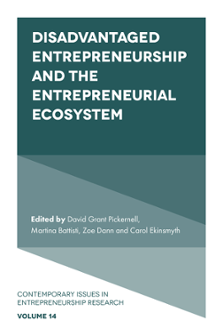
Index
Disadvantaged Entrepreneurship and the Entrepreneurial Ecosystem
ISBN: 978-1-80071-451-9, eISBN: 978-1-80071-450-2
ISSN: 2040-7246
Publication date: 17 January 2022
Citation
(2022), "Index", Pickernell, D.G., Battisti, M., Dann, Z. and Ekinsmyth, C. (Ed.) Disadvantaged Entrepreneurship and the Entrepreneurial Ecosystem (Contemporary Issues in Entrepreneurship Research, Vol. 14), Emerald Publishing Limited, Leeds, pp. 225-231. https://doi.org/10.1108/S2040-724620220000014014
Publisher
:Emerald Publishing Limited
Copyright © 2022 Emerald Publishing Limited
INDEX
Note: Page numbers followed by “n” indicate notes.
- Prelims
- Chapter 1: Disadvantaged Entrepreneurship and the Entrepreneurial Ecosystem: A Critical Literature Review and Introduction
- Theme 1: Background and Theory
- Chapter 2: The (Mixed) Motivations of Those Engaged in Enterprise and Experiencing Poverty
- Chapter 3: The Influence of Human Capital in Entrepreneurial Intention in Deprived Areas: A Theoretical Framework
- Theme 2: Contexts
- Chapter 4: A Gendered Perspective Applied to Latin American Entrepreneurial Ecosystems
- Chapter 5: Migrant Women Entrepreneurship and The Entrepreneurial Ecosystem
- Chapter 6: How do Refugee Entrepreneurs Navigate Institutional Voids? Insights from Malaysia
- Theme 3: Ecosystem Substitutes and Compliments
- Chapter 7: Relational Dynamics within Refugee Business Incubators: Bridging Refugee Entrepreneurs to the Host-Country Entrepreneurial Ecosystem
- Chapter 8: Disadvantaged Entrepreneurship Development: The Role of Civil Society Organisations in the Sierra Leone Petty Trading Entrepreneurial Ecosystem
- Chapter 9: The Ecosystem of UK Social Entrepreneurship: A Meta-Analysis of Contemporary Studies
- Chapter 10: Disadvantaged Entrepreneurship and the Entrepreneurial Ecosystem: Conclusions and Areas for Future Research
- Index